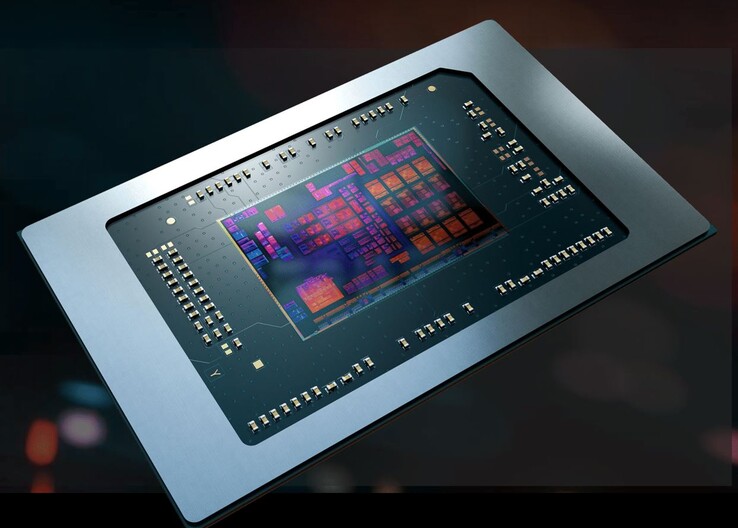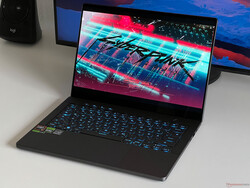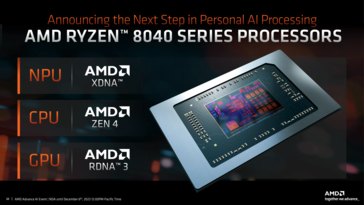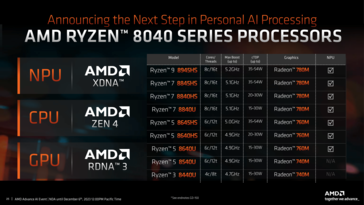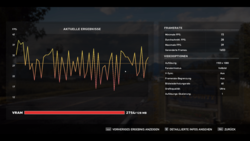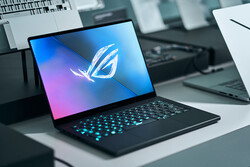AMD Ryzen 8000 Hawk Point in testing - Zen4 refresh outperforms Meteor Lake in number crunching and GPU performance
While Intel recently introduced significant changes to its mobile processors with the Meteor Lake generation, AMD is opting for a more conservative approach with the new Ryzen 8000 processors (codenamed Hawk Point). The chips still rely on the Zen4 architecture, and there are minimal alterations to clock speeds. However, AMD claims improvements in AI performance.
Additionally, there are no changes to the integrated graphics card, and AMD has retained the same name, Radeon 780M. We will also assess its performance in comparison to the new Arc iGPU (8 cores) from Intel, both in synthetic and gaming tests.
Test system - Asus ROG Zephyrus G14
We are using the Asus ROG Zephyrus G14 to evaluate the new Ryzen 9 8945HS this year, much like we did with the Ryzen 9 7940HS last year. We have tested it extensively and believe it to be a great product overall, with a housing that is significantly smaller than the previous model. The highest power limit of the processor is still 80 watts, but the cooling system cannot maintain this figure for very long, so we run testing in the performance mode, where power restrictions are 65/45 watts. A 32 GB LPDDR5X-6400 RAM module is included with our Zephyrus test device..
We have a number of devices that we can compare to the Meteor Lake benchmarks, including the MSI Prestige 16 and the Asus ROG Zephyrus G16, which have similar power limitations. In the latter case, the maximum power consumption for the Core Ultra 7 155H is 110 watts. On the other end of the spectrum is the compact MSI Prestige 13, where the 15–30 watt Core Ultra 7 155H.
AMD Ryzen 8000 Hawk Point overview
The Hawk Point known as Ryzen 8000 processors are essentially a redesigned version of the Phoenix mobile CPUs from the previous year, with only a few small tweaks. While the designations have been updated (the '8' at the beginning representing the year 2024, and the '4' in the third position signifying Zen4 cores), the core configurations and maximum clock speeds remain unchanged. For instance, the specifications of the new Ryzen 9 8945HS are identical to the old Ryzen 9 7940HS, featuring 8 Zen4 cores (16 threads, 4 nm process) with a maximum clock speed of 5.2 GHz, 8 MB L2 cache, and 16 MB L3 cache. AMD has simplified things for customers, as all 8000 models are based on Zen4 cores.
While Intel has adopted a tile design for its new Meteor Lake mobile processors, AMD continues to use a monolithic architecture. The integrated graphics card remains unchanged, with the classic Radeon 780M (RDNA3).
AMD only claims a considerable performance boost over last year's Ryzen 7000 models in the NPU, which is achieved through an increase in clock speed. However, we are now only able to validate these assertions with difficulty because there are no truly appropriate and standardised test procedures.
Test procedure
To provide a realistic comparison between different processors and graphics cards, we consider power consumption in addition to pure performance in synthetic evaluations, and then calculate efficiency. Consumption measurements are always taken on an external monitor to rule out the possibility of different internal displays impacting the results. Nonetheless, we measure the system's entire usage rather than relying solely on the stated CPU and GPU statistics.
Single-core performance & efficiency
The new Ryzen 9 8945HS has similar single-core performance to last year's Ryzen 9 7940HS and Ryzen 7 7840HS. This means that the AMD CPU lags behind Intel's previous Raptor Lake models but outperforms recent Meteor Lake chips like the Core Ultra 7 155H, which have lost part of their single-core performance. Apple was able to make a huge stride forward with the new M3 chips, which are much ahead of the Ryzen 9 8495HS in native benchmarks.
There are also no major surprises in terms of single-core efficiency. The new Ryzen 9 8945HS is on a par with its predecessors and well ahead of most Intel competitors with comparable power limits. It is remarkable that Intel was unable to improve single-core efficiency despite lower speed, and the Acer Swift Go 14 with the Core Ultra 7 155H lags behind the AMD chip and can only compete with the strong Raptor Lake CPUs. Apple is still clearly ahead of AMD when it comes to single-core efficiency.
Multi-core performance & efficiency
The multi-core performance remains consistently strong, particularly considering the imposed power limits. In multi-tests, the new Meteor Lake processors from Intel are more competitive and, depending on the set power limit, may even take the lead. However, AMD is expected to maintain an advantage in most scenarios, especially in compact or thin laptops. In Cinebench tests, AMD outperforms the new Apple M3 Pro (14 CPU cores), although the Apple chip excels in Geekbench. Notably, Apple holds a trump card with the M3 Max, offering CPU performance in the 14-inch range, a feat matched by AMD and Intel only with the HX processors, albeit exclusively in 16-inch devices.
* ... smaller is better
The efficiency of the HS processors is naturally lower than that of the U-series chips, a characteristic shared with Intel's counterparts. In essence, the efficiency remains comparable to the Ryzen 9 7940HS when power limits are maintained at the same level. We anticipate that the U-series processors will continue to perform at a level similar to the Ryzen 7000 processors, bringing them close to the capabilities of Apple's M3 Pro processors.
Performance at different TDP values
Directly comparing the performance of processors in laptops is often challenging due to the use of different power limits. As in our previous tests, we have examined the multi-core performance at various TDP values. Despite the Zephyrus G14's ability to reach a maximum of 80 watts, it struggles to maintain stability for a full benchmark run, prompting us to initiate testing at 65 watts. This analysis indicates that there is no significant difference between the new Ryzen 9 8945HS and the old Ryzen 9 7940HS, with variances falling within the normal fluctuation range. However, it's evident that the new Meteor Lake Core Ultra 7 155H holds an advantage over the older Core i7-13700H from Intel, though it still falls short of matching AMD's competition. This underscores the ongoing trend that Intel tends to require higher power limits to achieve comparable performance.
| TDP | Ryzen 9 8945HS | Ryzen 9 7940HS | Core Ultra 7 155H | Core i7-13700H |
|---|---|---|---|---|
| 65 Watt | 17.077 Punkte | 17.402 Punkte | 16.596 Punkte | 15.762 Punkte |
| 55 Watt | 16.482 Punkte | 16.607 Punkte | 15.080 Punkte | 14.544 Punkte |
| 45 Watt | 15.506 Punkte | 15.625 Punkte | 14.143 Punkte | 13.141 Punkte |
| 35 Watt | 14.423 Punkte | 13.723 Punkte | 12.387 Punkte | 11.211 Punkte |
Power consumption in idle mode
We also tested the power consumption of the two processors in idle mode, using identical settings for both laptops (Zephyrus G14 & G16) with energy profiles set to Quiet, Windows performance mode on Best Energy Saving, and WLAN deactivated. The results reveal an advantage of Intel's new Tile approach, as the Core Ultra consumes almost exactly 1 watt less on average compared to the Ryzen 9.
Radeon 780M vs. Arc iGPU
As previously stated, there have been no changes to the Radeon 780M (RDNA3) since we completed a thorough analysis of it last year. However, the comparison with Intel's new Arc GPU (8 cores) is particularly noteworthy, as performance has improved significantly for the first time in years. The two Asus laptops, ROG Zephyrus G14 (Adrenalin 24.1.1) and Zephyrus G16 (Intel 101.5126), were designed for the following testing. However, the Arc GPU in the G16 produced extremely poor performance results. To do further research, we evaluated the performance of three more Meteor Lake devices (ZenBook 14 OLED, HP Spectre x360 14 and MSI Prestige 13). Overall, synthetic testing show a substantial variance in findings.
| 3DMark | |
| 1920x1080 Fire Strike Graphics | |
| Acer Swift Go 14 SFG14-72 | |
| MSI Prestige 16 B1MG-001US | |
| Tuxedo Pulse 14 Gen3 | |
| Asus ROG Zephyrus G14 2024 GA403U | |
| Lenovo Yoga Pro 7 14APH G8 | |
| HP Spectre x360 14-eu0078ng | |
| Asus ZenBook 14 UX3405MA | |
| Asus ROG Zephyrus G16 2024 GU605M | |
| MSI Prestige 13 AI Evo | |
| 2560x1440 Time Spy Graphics | |
| MSI Prestige 16 B1MG-001US | |
| Asus ZenBook 14 UX3405MA | |
| Acer Swift Go 14 SFG14-72 | |
| Tuxedo Pulse 14 Gen3 | |
| HP Spectre x360 14-eu0078ng | |
| Asus ROG Zephyrus G14 2024 GA403U | |
| Lenovo Yoga Pro 7 14APH G8 | |
| Asus ROG Zephyrus G16 2024 GU605M | |
| MSI Prestige 13 AI Evo | |
| Wild Life Extreme Unlimited | |
| Asus ZenBook 14 UX3405MA | |
| Acer Swift Go 14 SFG14-72 | |
| HP Spectre x360 14-eu0078ng | |
| Tuxedo Pulse 14 Gen3 | |
| Lenovo Yoga Pro 7 14APH G8 | |
| Geekbench 5.5 - OpenCL Score | |
| Tuxedo Pulse 14 Gen3 | |
| Lenovo Yoga Pro 7 14APH G8 | |
| Asus ROG Zephyrus G14 2024 GA403U | |
| MSI Prestige 16 B1MG-001US | |
| HP Spectre x360 14-eu0078ng | |
| Asus ZenBook 14 UX3405MA | |
| Acer Swift Go 14 SFG14-72 | |
| Asus ROG Zephyrus G16 2024 GU605M | |
| MSI Prestige 13 AI Evo | |
| Geekbench 6.5 - GPU OpenCL | |
| MSI Prestige 16 B1MG-001US | |
| HP Spectre x360 14-eu0078ng | |
| Asus ZenBook 14 UX3405MA | |
| Tuxedo Pulse 14 Gen3 | |
| Asus ROG Zephyrus G14 2024 GA403U | |
| Lenovo Yoga Pro 7 14APH G8 | |
| Acer Swift Go 14 SFG14-72 | |
| Asus ROG Zephyrus G16 2024 GU605M | |
| MSI Prestige 13 AI Evo | |
The performance of the Radeon 780M in synthetic benchmarks is well-documented and depends on the RAM configuration. The new Arc-iGPU with 8 cores demonstrates an advantage in demanding tests such as 3DMark Time Spy and the OpenCL tests from Geekbench. There are, of course, notable differences depending on the model; for instance, the fastest Radeon 780M is 16% slower in the Time Spy test compared to the Arc-iGPU in the MSI Prestige 16.
| Performance rating - Percent | |
| Tuxedo Pulse 14 Gen3 | |
| Asus ROG Zephyrus G14 2024 GA403U | |
| Lenovo Yoga Pro 7 14APH G8 | |
| MSI Prestige 16 B1MG-001US -1! | |
| Acer Swift Go 14 SFG14-72 | |
| HP Spectre x360 14-eu0078ng | |
| Asus ZenBook 14 UX3405MA | |
| Asus ROG Zephyrus G16 2024 GU605M | |
| MSI Prestige 13 AI Evo | |
| The Witcher 3 - 1920x1080 Ultra Graphics & Postprocessing (HBAO+) | |
| Tuxedo Pulse 14 Gen3 | |
| Lenovo Yoga Pro 7 14APH G8 | |
| Asus ROG Zephyrus G14 2024 GA403U | |
| MSI Prestige 16 B1MG-001US | |
| Acer Swift Go 14 SFG14-72 | |
| HP Spectre x360 14-eu0078ng | |
| Asus ZenBook 14 UX3405MA | |
| Asus ROG Zephyrus G16 2024 GU605M | |
| MSI Prestige 13 AI Evo | |
| GTA V - 1920x1080 Highest AA:4xMSAA + FX AF:16x | |
| Tuxedo Pulse 14 Gen3 | |
| Asus ROG Zephyrus G14 2024 GA403U | |
| Lenovo Yoga Pro 7 14APH G8 | |
| HP Spectre x360 14-eu0078ng | |
| Asus ZenBook 14 UX3405MA | |
| Acer Swift Go 14 SFG14-72 | |
| Asus ROG Zephyrus G16 2024 GU605M | |
| MSI Prestige 13 AI Evo | |
| Final Fantasy XV Benchmark - 1920x1080 High Quality | |
| Tuxedo Pulse 14 Gen3 | |
| Lenovo Yoga Pro 7 14APH G8 | |
| Asus ROG Zephyrus G14 2024 GA403U | |
| HP Spectre x360 14-eu0078ng | |
| MSI Prestige 16 B1MG-001US | |
| Asus ZenBook 14 UX3405MA | |
| Asus ROG Zephyrus G16 2024 GU605M | |
| Acer Swift Go 14 SFG14-72 | |
| MSI Prestige 13 AI Evo | |
| Strange Brigade - 1920x1080 ultra AA:ultra AF:16 | |
| Tuxedo Pulse 14 Gen3 | |
| Lenovo Yoga Pro 7 14APH G8 | |
| Asus ROG Zephyrus G14 2024 GA403U | |
| MSI Prestige 16 B1MG-001US | |
| Acer Swift Go 14 SFG14-72 | |
| Asus ROG Zephyrus G16 2024 GU605M | |
| Asus ZenBook 14 UX3405MA | |
| HP Spectre x360 14-eu0078ng | |
| MSI Prestige 13 AI Evo | |
| Dota 2 Reborn - 1920x1080 ultra (3/3) best looking | |
| Tuxedo Pulse 14 Gen3 | |
| MSI Prestige 16 B1MG-001US | |
| Acer Swift Go 14 SFG14-72 | |
| Asus ROG Zephyrus G14 2024 GA403U | |
| Lenovo Yoga Pro 7 14APH G8 | |
| Asus ROG Zephyrus G16 2024 GU605M | |
| HP Spectre x360 14-eu0078ng | |
| Asus ZenBook 14 UX3405MA | |
| MSI Prestige 13 AI Evo | |
| X-Plane 11.11 - 1920x1080 high (fps_test=3) | |
| MSI Prestige 16 B1MG-001US | |
| Acer Swift Go 14 SFG14-72 | |
| Tuxedo Pulse 14 Gen3 | |
| Asus ROG Zephyrus G14 2024 GA403U | |
| Asus ROG Zephyrus G16 2024 GU605M | |
| MSI Prestige 13 AI Evo | |
| HP Spectre x360 14-eu0078ng | |
| Asus ZenBook 14 UX3405MA | |
| Lenovo Yoga Pro 7 14APH G8 | |
However, in gaming tests, the Radeon 780M consistently surpasses the new Arc iGPU, with the MSI Prestige 16 coming close in some scenarios. Essentially, if gaming with the iGPU is a priority, the Radeon 780M remains the best option. It seems that there are issues with the drivers for the new Intel iGPU. This causes testing to show inconsistent FPS numbers and poor performance, which prevents fluid gameplay. The benchmark performance of Far Cry 5 (Ultra settings) on the new Asus ZenBook 14 OLED serves as an instructive example. Although the game runs smoothly on average at 28 frames per second, there are noticeable variations (which also affect gameplay at lesser settings). Similar problems were seen when playing Witcher 3, as seen in the table below. However, we expect to see improvements with future driver releases.
Verdict - Ryzen 8000 without major innovations, but still ahead of Intel
While the new AMD mobile processors in the Ryzen 8000 series may not offer immediate discernible improvements for users, there is a slight uptick in performance in certain scenarios, albeit likely unnoticed by most. The increased AI performance, too, may not be readily apparent. Nonetheless, the advantage for customers lies in the fact that all Ryzen 8000 processors are now based on the latest Zen4 cores. In contrast, last year's Ryzen 7000 generation had to be more cautious in this aspect, indicating potential for improved availability, though only time will tell if this expectation holds true.
Multi-core performance, heavily contingent on power limits and cooling, still leans in favor of AMD, even with identical power consumption, although Intel is making strides to catch up. Intriguingly, the single-core performance of the new Intel chips is slightly lower than that of the old Raptor Lake chips, putting Intel slightly behind the AMD models in this regard. However, even the new Ryzen 8000 models cannot compete with Apple's latest M3 chips.
The Ryzen 8000 mobile processors offer slight improvements, featuring robust Zen4 chips that can contend with Intel's new Meteor Lake mobile processors. In gaming, the Radeon 780M maintains an advantage.
The Radeon 780M remains unchanged and concedes to Intel's new Arc iGPU in synthetic tests, particularly the top model with 8 cores. In gaming, AMD clearly outperforms the Intel iGPU, though the latter may benefit from future driver updates.
For customers, understanding the expected performance from AMD processors is relatively straightforward. The differentiation between CPUs of the U and HS series is clear, and achieving good performance values doesn't necessitate astronomical power limits. In contrast, Intel presents a challenge as power limits can vary significantly, with the new Core Ultra 7 155H alone showing a range from 15 to 110 watts, impacting power substantially.




